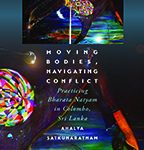
“Meticulously researched and thoughtfully argued, Moving Bodies makes a case for understanding dance as central to ethnic conflict while also describing dance as a vehicle for resistance.”
—Nandini Sikand, author of Languid Bodies, Grounded Stances: The Curving Pathway of Neoclassical Odissi Dance
This book provides a fascinating account of a dance form as a mapping tool of the politics of identity that interrogates the limits and possibility of thinking about citizenship.”
—Rachmi Diyah Larasati, author of The Dance That Makes You Vanish: Cultural Reconstruction in Post-Genocide Indonesia
How can dance be sustained by its practitioners in the unstable political and geographical landscape of war? This question lies at the heart of Moving Bodies, Navigating Conflict: Practicing Bharata Natyam in Colombo, Sri Lanka , a groundbreaking ethnographic examination of dance practice in Colombo, Sri Lanka, during the civil war (1983–2009), which claimed more than 100,000 lives. It is the first book of scholarship on bharata natyam (a classical dance originating in India) in Sri Lanka, and the first on the role of dance in the country’s war, between the Sinhalese-Buddhist–led government and the separatists, the Liberation Tigers of Tamil Eelam, which had fought for an independent state for the Tamil minority.
Focusing on women bharata natyam dancers, Ahalya Satkunaratnam shows how they navigated conditions of conflict and a neoliberal, global economy, resisted nationalism and militarism, and advocated for peace. Her interdisciplinary methodology combines historical analysis, methods of dance studies, and dance ethnography. With the war, dance was given a desired symbolic value that hid undesired bodies and was simultaneously a means of ascribing bodies value—materially, rhetorically, and visually. Satkunaratnam examines the relationships between aesthetics, embodied forms, and political work, the intersections of gender and sexuality with cultural practice and ethnic identity, and the experience of war and militarism in Sri Lanka. War charges dance with additional value, as cultural representations are desired by forces of nationalism and conflict. Yet, argues Satkunaratnam, dance practice can also become a vehicle for the individual to resist such claims.
AHALYA SATKUNARATNAM is professor of arts and humanities at Quest University Canada located in the unceded territories of the Skwxwú7mesh (Squamish) peoples. A dancer and choreographer, she has performed across the United States, Canada, India, and Sri Lanka. Her creative work has been supported by the Canada Council for the Arts and the Illinois Arts Council.








